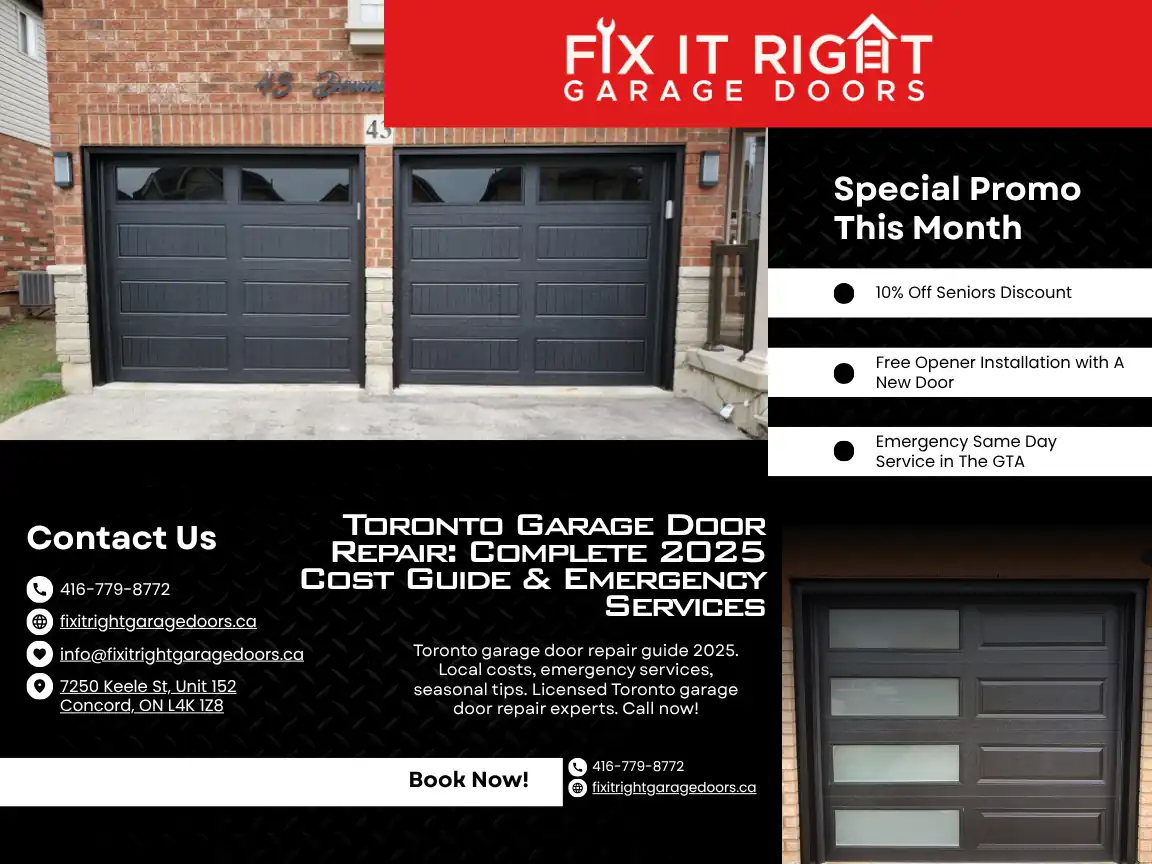Your garage door is more than just a barrier for vehicles and stored goods; it’s a gateway to your home or business. If inadequately secured, it can become a prime target for thieves looking for easy access. From advanced rolling code technology to heavy-duty reinforcement, employing the right garage door security tips is crucial to prevent garage break-ins.
In this extensive guide, we discuss the importance of solid garage door security, examine modern solutions designed to deter intruders, and highlight maintenance practices that ensure long-term door integrity. Whether you’re safeguarding family heirlooms in a residential garage or protecting expensive equipment at a commercial property in the GTA, adopting these strategies can drastically reduce security vulnerabilities. By the end of this post, you’ll have a detailed roadmap for achieving an impenetrable garage environment, reinforcing peace of mind for everyone who relies on your property.
Why Garage Door Security Matters
Whether you’re operating a busy storefront or simply storing personal belongings, the garage often contains high-value or sensitive items. Failing to properly secure your garage door can lead to devastating consequences:
- Entry to Main Property: Many garages link directly to living spaces or critical commercial areas, enabling thieves to move deeper into the premises if they breach the door.
- Valuable Inventory: Automotive tools, power equipment, or even confidential files can all be prime targets for thieves if left unprotected.
- Physical Safety: Intruders who gain entry through the garage may confront residents or employees, creating a dangerous situation.
- Insurance and Liability: Under-secured garages can lead to higher insurance rates or disputes during claims, particularly for commercial policies.
By focusing on how to prevent garage break-ins, you invest in securing not just material goods but also the well-being of the people who live or work on the property.
Common Vulnerabilities in Garage Doors
Even sturdy garage doors have weak spots that criminals can exploit. Understanding these is the first step in applying robust garage door security tips.
- Outdated Opener Technology: Older garage door openers that rely on fixed codes can be easily hacked using code-grabbing devices.
- Poor Sealing and Gaps: A door that doesn’t close flush might leave enough space for prying tools.
- Thin or Flimsy Panels: Certain older doors or low-grade materials can be bent or punctured with minimal force.
- Manual Release Cord: Intruders may thread tools through small openings or windows to grab and pull the emergency release, disengaging the door from the opener.
- Neglected Maintenance: Loose tracks, rusty hinges, or broken rollers can leave the door partially open or easily manipulable.
Each of these points underscores the importance of regular inspection and upgrades where necessary. If any vulnerability persists, your efforts to prevent garage break-ins are significantly diminished.


Modern Security Features to Prevent Garage Break-Ins
Recent technology has made it harder for criminals to exploit door weaknesses. Upgrading to more advanced features is one of the best garage door security tips for homeowners and business owners alike.
Rolling Code Garage Door Openers
Instead of relying on a single, static code, rolling code systems generate a fresh code each time you use the remote. This process—often called “hopping code” or “rolling code”—renders code-grabbing attempts nearly useless. Modern versions often allow integration with smartphone apps, enabling you to:
- Monitor Door Status Remotely: Check if the door is closed, especially helpful if you forget to verify before leaving.
- Receive Activity Alerts: A text or push notification if the door is opened outside normal hours.
- Lock Remote Access: You can quickly disable a lost remote, ensuring it can’t be used by strangers.
Secure Keypad Systems
Traditional four-digit keypads provide some measure of security, but they can be improved. Modern variants include:
- Biometric Scanners: Fingerprint or palm scanners that virtually eliminate guesswork.
- Smart Keypads: Systems that lock after a certain number of wrong PIN attempts, foiling brute-force guessers.
- Robust Construction: Weatherproof materials and tamper-resistant enclosures.
Motion-Detecting Lights and Cameras
Criminals prefer dark, unobserved spaces. Installing motion-activated lights around your garage door can deter them instantly. When paired with a camera system, you gain:
- Instant Illumination: Floodlights or spotlights discourage nighttime snooping.
- Remote Footage Access: Many cameras sync with phone apps, letting you view live or recorded feeds.
- Two-Way Audio: Some smart cameras feature speakers and microphones, allowing you to confront suspicious individuals verbally.
Smart Garage Hub Integration
If you have a smart home platform, connecting your garage door to it can yield streamlined security benefits:
- Auto-Lock Functions: If you forget to shut the door, it can close automatically after a set time.
- Geofencing: The door could open or lock based on your phone’s location, ensuring it remains secured when you’re away.
- Combined Sensors: Integrate motion or door-sensor triggers with other home automation, like turning on indoor lights if the door is opened at an odd hour.
Physical Reinforcements
Even with advanced electronics, physical security measures remain key:
- Heavy-Duty Slide Locks: A secondary internal lock physically bars the door from opening, preventing forced lifts.
- Steel Braces: Reinforcement bars spanning across door panels add rigidity, toughening it against prying or ramming attempts.
- Upgraded Hinges and Bolts: Thicker, rust-resistant hardware can make forced entry significantly more time-consuming.
Essential Garage Door Security Tips for Homeowners
Protecting a residential garage often blends the convenience of everyday living with the need for tight security. Implementing these garage door security tips balances ease of use with robust defense.
- Keep the Door Closed
- Never leave your garage door open, even if you’ll only be in the backyard briefly. Thieves can quickly slip inside and grab valuables.
- Install a Peephole or Small Window
- Being able to check inside the garage without opening the entire door can prevent inadvertently revealing your possessions.
- Don’t Leave the Remote in Your Car
- Break-ins frequently occur to vehicles parked in driveways, so store the remote in a secure place or use a keychain version.
- Secure the Interior Access Door
- If your garage connects to the main house, reinforce that door with a deadbolt or smart lock, treating it like any other external entry.
- Use Timed Lighting
- Smart or timed lights in and around the garage create the impression that someone’s present, even if the space is unoccupied.
Beyond these daily habits, a routine inspection of the door’s mechanical parts further ensures minimal chances for criminals to exploit overlooked weaknesses.
Advanced Measures for Businesses and Commercial Spaces
Companies with larger inventories or high-value equipment require a more aggressive approach to prevent garage break-ins.
Access Control Systems
- RFID Badges and Keycards: Each employee has personalized access privileges, simplifying the process of adding or revoking permissions.
- Audit Logs: Digital systems record every door opening and closing, helping spot suspicious activity patterns.
High-Security Rolling Steel Doors
- Thicker Slats: Resist prying or cutting tools.
- Wind-Load Ratings: Doors designed to withstand heavy winds offer extra durability against forced entry attempts or environmental damage.
Integrated Alarm Responses
- Silent Alarms: Useful when stealth is advantageous to catch perpetrators in the act.
- Live Monitoring: Business owners or security staff receive immediate notifications of suspicious door activity.
Loading Dock Seals and Shelters
- Physical Barricades: Extended seals make it harder to slip between the truck and the dock edge.
- Security Grilles: Some businesses add retractable grilles or bars behind overhead doors for an added layer of defense.
When layered properly, these measures transform your loading bay or warehouse doors from potential break-in targets to formidable barriers no thief wants to tackle.
Comparison of Security Upgrades
Here is a side-by-side look at some popular security features, their complexity, and general cost, offering a snapshot of how each might fit into your garage door security tips plan.
| Security Feature | Complexity to Implement | Cost Range | Maintenance Needs | Primary Benefit |
|---|---|---|---|---|
| Rolling Code Openers | Low to Moderate | $100 – $300+ | Occasional remote battery checks | Prevents code grabbing, integrated smartphone alerts |
| Secure Keypad Systems | Low to Moderate | $50 – $200+ | Battery replacement, keypad cleaning | Advanced PIN or biometric locks deter guesswork |
| Motion-Detecting Lights | Low | $30 – $150+ | Bulb changes, angle adjustments | Illuminates suspicious activity, discouraging nighttime theft |
| Smart Garage Hub Integration | Moderate to High | $100 – $400+ | Software updates, stable Wi-Fi connection | Remote access, real-time alerts, automated closure |
| High-Security Steel Doors | High | $1,000 – $2,000+ installed | Lubrication, anti-rust coatings | Extreme durability, wind-load resistance, forced-entry block |
Select a combination of strategies that match your budget, desired complexity, and the specific threats your property faces.
Maintenance and Best Practices
No matter how advanced your door’s security features are, consistent upkeep is crucial to ensure they function at their best.
Regular Visual Inspections
- Monthly Check: Look for any cracks, warping, or signs of tampering.
- Track and Roller Clearance: Ensure rollers stay aligned and move smoothly, so the door closes fully.
Lubrication
- Springs and Hinges: Applying a silicone-based lubricant reduces friction.
- Lock Mechanisms: Periodically oil internal slide locks, as rust can jam them when you need them most.
Testing Alarm or Sensor Systems
- Motion Sensors: Walk past them after dark to confirm they trigger external lights.
- Auto-Reverse Mechanism: Place a small item under the closing path to check if the door reverses instantly upon contact.
Seasonal Adjustments
- Winter Readiness: Cold weather can affect door materials. Keep an eye on seals and ensure no ice buildup.
- Summer Heat: High temperatures cause metal expansion, potentially impacting track alignment. Quick tune-ups address these subtle shifts.
Signs of a Potential Security Breach
Stay vigilant for signals that criminals might be scouting your garage or that your existing measures are weakening:
- Door Isn’t Closing Flush: You see daylight or feel drafts, suggesting a sealing or alignment problem.
- Remote Acting Erratically: Random openings or closings could mean interference or attempted hacking.
- Minor Dents or Pry Marks: Physical indications near door edges might be thieves testing your defenses.
- Flickering Lights or Offline Cameras: Intruders sometimes sabotage lights or disable camera feeds.
- Damaged Weather Strips: Missing or torn weather strips can offer leverage points for crowbars.
Addressing these red flags quickly lowers the chances of future, more aggressive break-in attempts.
Quick Garage Door Security Checklist
Below is a handy reference to monitor your garage door security tips regularly.
| Action | Recommended Frequency | Why It’s Important |
|---|---|---|
| Inspect Panels and Seals | Monthly | Identifies vulnerabilities, potential pry points |
| Lubricate Rollers, Hinges, Springs | Every 3–6 months | Extends hardware life, ensures smooth operation |
| Verify Rolling Code Function | Twice a year | Confirms new codes generate properly, preventing hacking |
| Test Auto-Reverse Sensor | Monthly | Ensures the door doesn’t close on objects or people |
| Check Motion-Detecting Lights | Monthly | Guarantees lights activate, scaring away intruders |
| Update Smart App Credentials | As needed (password changes) | Keeps unauthorized users from hijacking door controls |
Adhering to this schedule supports both mechanical reliability and robust security for your garage.
Real-World Example: Upgrading Security in the GTA
A Toronto-based carpentry shop struggled with frequent theft attempts. Traditional single-code garage openers and minimal lighting allowed thieves to operate unnoticed. After consulting with a local security provider, the owner implemented:
- Rolling Code Openers and Smart Hub
- Immediately eliminated code-grabbing as a viable intrusion method.
- Provided real-time alerts and remote closure options.
- Motion-Activated Floodlights
- Any movement near the door triggered bright illumination, deterring nighttime prowlers.
- Employee vehicles also benefited from added visibility after closing shifts.
- Heavy-Duty Slide Locks and Reinforced Panels
- Upgraded metal bars blocked forced lifts from the outside.
- Thicker paneling with interior braces resisted bending at the center.
- Biannual Maintenance Schedule
- A professional technician visited twice a year to recalibrate openers, tighten hardware, and replace worn seals.
- This proactive approach prevented minor wear from escalating into security gaps.
Post-upgrade, the shop noticed zero successful break-in attempts, improved employee confidence, and even reduced insurance premiums. This case highlights the effectiveness of layered approaches—combining modern technology, physical reinforcement, and systematic upkeep.
Conclusion
Strengthening your garage door’s defenses is about more than just installing a good lock or upgrading to a modern opener. True security emerges from a holistic approach, one that includes mechanical maintenance, smart technology, and vigilance regarding potential weak points. Whether you’re a homeowner shielding personal belongings or a business safeguarding revenue-critical assets, these garage door security tips can dramatically prevent garage break-ins and deter opportunistic thieves.
Key takeaways to keep in mind:
- Upgrade Outdated Systems: Replace fixed-code openers with rolling code models.
- Reinforce Physical Weak Points: Use sturdy locks, braces, and robust door materials.
- Embrace Technology: Consider smart hubs, cameras, and motion sensors for real-time monitoring and control.
- Stay Proactive with Maintenance: Regularly lubricate moving parts, test locks and sensors, and address even minor issues early on.
For property owners in the GTA, professional services like Fix It Right Garage Doors can tailor specialized solutions that handle local conditions, from bitter winters to urban congestion, and ensure your garage stands firm against would-be intruders.










